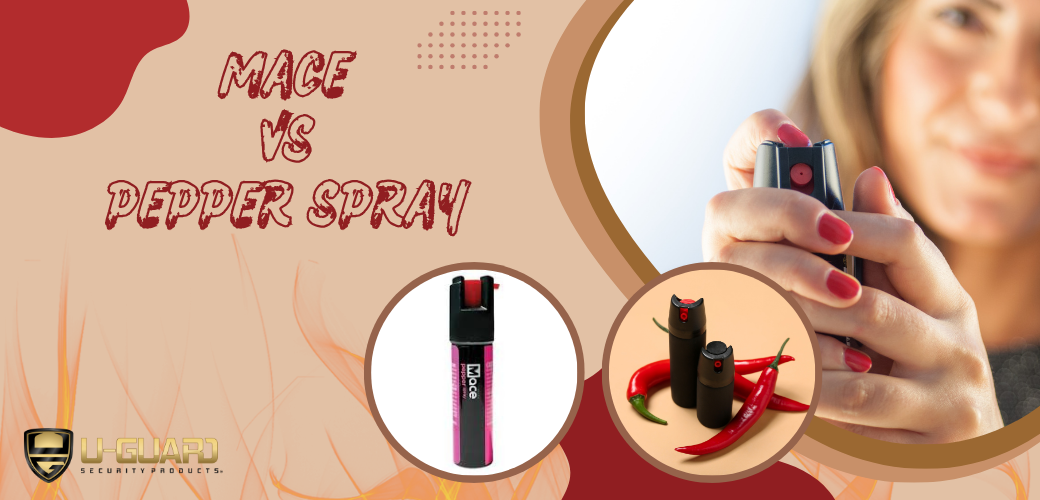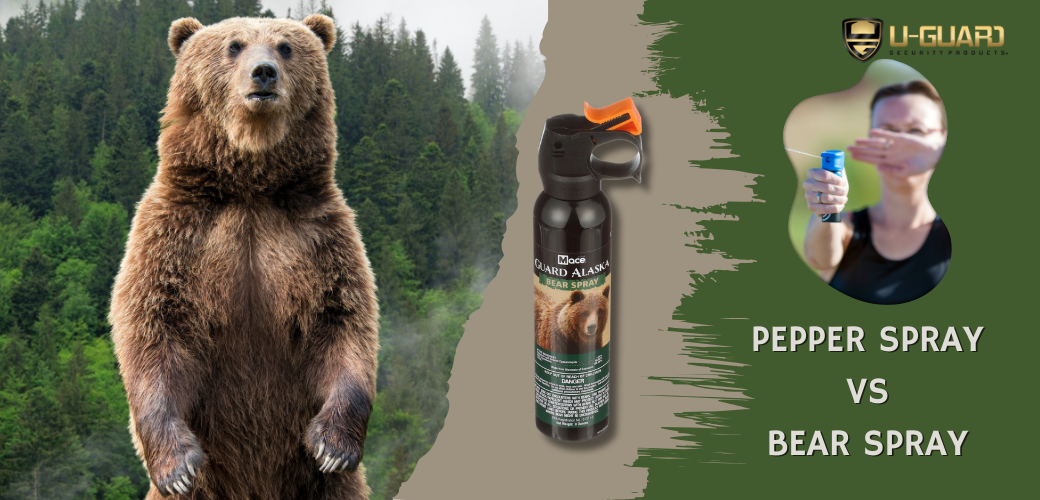Have you ever wondered, “Is mace and pepper spray the same?” In the realm of personal safety and self-defense, the terms “mace” and “pepper spray” are often used interchangeably. However, there are key differences between the two that are important to understand. In this blog post, we’ll review and look into the world of mace and pepper spray, uncovering the truth behind their composition, effectiveness, and legal implications. Let’s separate fact from fiction and unravel the mysteries surrounding these popular self-defense tools.
Mace vs Pepper Spray: Clearing the Air on Common Misconceptions
Amidst the swirl of terminology in personal safety discussions, the distinction between mace and pepper spray often becomes blurred. The critical difference lies within their compositions, a pivotal factor affecting their application in self-defense scenarios. Historically, ‘Mace’ was a brand name that became synonymous with self-defense sprays, much like ‘Kleenex’ did for tissues. Originally, Mace products contained phenacyl chloride (CN), a chemical irritant commonly referred to as tear gas. Over time, due to the evolving landscape of personal safety products, Mace began incorporating oleoresin capsicum (OC) — the same natural ingredient found in pepper spray — into their formulations, aligning more closely with what is typically recognized as pepper spray today.
Pepper spray, by its very nature, is derived from capsaicin, the compound that gives hot peppers their heat. This organic origin renders it a natural product, contrasting with the synthetic chemical compounds like CS gas that may be found in other self-defense tools. The critical takeaway is recognizing that the effectiveness, reaction time, and overall impact on the target can vary significantly between these substances. This insight into the ingredients and their effects is not just academic; it directly influences the choice of self-defense tools, guiding individuals towards options that best suit their needs and ethical considerations.
The Non-Lethal Nature of Mace and Pepper Spray Explained
In the landscape of personal defense options, the appeal of mace and pepper spray lies significantly in their capacity to neutralize a threat without inflicting long-term harm. This attribute aligns with the principle of minimizing harm while ensuring personal safety, a critical consideration in scenarios where the use of lethal force is neither necessary nor justified. These tools work by temporarily impairing the assailant’s ability to see or breathe, providing the user with a crucial window of opportunity to escape or seek help. The design and intention behind these self-defense sprays are rooted in the philosophy of restraint and responsibility, offering a means of protection that respects the sanctity of life.
Understanding the non-lethal nature of these sprays also involves recognizing their effects on the human body. The active ingredients in mace and pepper spray act on the sensory and respiratory systems, causing immediate but temporary discomfort. This incapacitation effect, however, is designed to be short-lived, typically wearing off within a short period, thereby minimizing the risk of long-term physical consequences to the recipient. This approach to personal defense underscores a broader commitment to ethical self-protection, where the goal is to deter or halt an attack without crossing the threshold into permanent injury or fatality.
Decoding the Ingredients: Chemical vs Natural Components
The debate between the utilization of chemical versus natural components in mace and pepper spray is a critical discussion point for those considering these tools for personal safety. Chemical-based agents, historically present in early versions of Mace, are synthetic irritants that can disrupt an assailant’s capacity to function by affecting their vision and respiratory system. On the other hand, pepper spray’s foundation in natural capsicum offers a potent, organic alternative. This natural compound, derived from chili peppers, works by inducing an intense burning sensation, leading to temporary blindness and difficulty breathing, thereby incapacitating an attacker without causing permanent harm.
Choosing between these two types of ingredients involves a balance of considerations, including the user’s sensitivity to synthetic chemicals, environmental concerns, and the context in which the self-defense spray is intended to be used. While natural capsaicin-based sprays are widely regarded for their effectiveness and immediate impact, some individuals may prioritize the specific attributes of chemical formulations for their self-defense strategy. This decision is deeply personal and reflects a broader conversation about the nature of self-protection and the ethical implications of incapacitating another individual, even in defense.
OC vs CS Formulation: What’s the Difference?
Peeling back the layers of confusion surrounding OC and CS formulations reveals a fundamental dichotomy in their origin and impact. OC, short for oleoresin capsicum, is a natural extract from chili peppers, wielding the fiery essence of its source to provoke an intense burning sensation on contact. This inflammatory reaction is immediate, affecting the eyes, skin, and respiratory system, thereby incapacitating an aggressor with nature’s own defense mechanism.
Contrastingly, CS (chlorobenzylidene malononitrile) pivots towards a synthetic approach. As a man-made chemical, CS operates by irritating mucous membranes in the eyes, nose, throat, and lungs. Its effects, though similar in purpose to OC’s incapacitating objectives, stem from a different chemical interaction, illustrating the varied paths to achieving temporary incapacitation.
The choice between OC and CS formulations isn’t merely a matter of natural versus synthetic. It extends into considerations of immediate effect, potential for allergic reactions, and the scenario in which the spray might be deployed. Understanding these distinctions empowers individuals to select a self-defense tool that aligns with their values, circumstances, and the nuances of personal safety in a complex world.
The Advantage of UV Dye in Pepper Spray
In the intricate world of self-defense measures, the inclusion of UV dye in pepper spray introduces a strategic advantage that extends beyond the immediate moment of use. This ingenious component serves as a silent ally in the aftermath of a confrontation, marking an assailant with an invisible but detectable tag. The significance of UV dye lies in its covert operation; to the naked eye, the assailant may appear unaffected, yet under ultraviolet light, law enforcement can swiftly and accurately identify the individual. This capability not only aids in the apprehension of the aggressor but also fortifies the user’s legal standing by providing tangible evidence of the encounter. The application of UV dye in pepper spray encapsulates a thoughtful approach to personal safety, blending immediate defensive action with a longer-term mechanism for accountability and justice. This feature underlines the meticulous design behind modern self-defense tools, emphasizing their role not just in providing immediate protection but also in weaving a tighter safety net for society. It’s a testament to the evolving landscape of personal security, where innovation continuously enhances the efficacy and utility of self-defense solutions.
Production Origins: Are Mace and Pepper Spray Made in the USA?
A common question is whether mace and pepper spray are manufactured within the United States illuminates an aspect of the self-defense industry that is as varied as it is intriguing. The production of these pivotal safety tools is not confined to a single geographic locale; instead, it spans a global landscape. Numerous brands and companies, rooted in a commitment to quality and efficacy, choose to base their manufacturing operations in the USA. This decision often stems from a desire to closely monitor production standards and adhere to stringent regulatory requirements, ensuring that the end product meets the high expectations of consumers seeking reliable means of protection.
However, it’s equally important to acknowledge that the self-defense market is a mosaic of international contributors. Some manufacturers opt to produce mace and pepper spray abroad, leveraging global resources and manufacturing capabilities. This diversity in production origins serves a dual purpose: it not only caters to a broad array of consumer preferences but also enriches the market with a variety of options, each bearing its unique attributes and advantages.
When considering the acquisition of mace or pepper spray, it becomes crucial to navigate this landscape with an informed perspective. Paying attention to the product’s origin can provide valuable insights into its quality, compliance with safety standards, and the ethical considerations behind its manufacturing process. In a realm where the stakes involve personal safety and security, making an informed choice transcends the mere act of purchase—it’s a step towards embracing preparedness and responsibility in one’s approach to self-defense.
Navigating the Legal Landscape: Regulations on Mace and Pepper Spray Use
Embarking on the journey of incorporating mace or pepper spray into your personal safety arsenal requires more than understanding their effects and origins; it demands a conscientious exploration of the legal framework that shapes their permissible use. Across the United States, the legal stance on these self-defense tools varies significantly from one jurisdiction to another, painting a complex tapestry of statutes and regulations. This diversity in legal perspectives underscores the importance of a proactive approach to compliance, urging individuals to delve deeply into the specifics of their local laws. By doing so, users ensure that their method of self-protection aligns not only with their personal safety strategies but also with the legal parameters designed to balance the right to self-defense with broader public safety considerations. Engaging with this aspect of mace and pepper spray usage is not merely a legal obligation; it’s a fundamental component of responsible ownership and application. Before using, or purchasing pepper spray and tear gas, check your local area for the pepper spray laws in your state, county or city.





